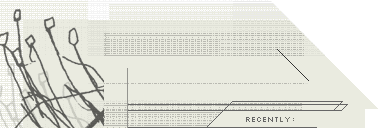Taking its name from the French word for concealing and safekeeping valuables, Cached houses
a plethora of audio trinkets and toys, each vibrantly life-affirming in its delicate
yet dense textures. Hopefully its contents won't remain secret for too long.
Cached is replete with citrus-sweet acoustic melodies, exuding
on the surface an
easygoing, drowsy mellowness, evocative of summer evenings on balconies overlooking
parks
teeming
with people. Adding a profusion of colors and timbres to what remains a quintessentially
rhythmic conception, electronic currents linger, undermine and insinuate themselves
into these songs, like wasps under the floorboards or mysterious noises in the
attic.
Nudge's approach is a common one: they subject improvised work to post-production
and editing and, lo and behold, the result is something new and fresh. The amusing
thing about Cached is its refusal to confine itself to the usual dogmas
of
the music styles it references (African rhythmic patterns, ambient sound sculpture,
and post-rock melancholia). The unbound passages sidestep desiccated orthodoxies
of academic improv with startling simplicity: repeating melodic motifs of Rhodes
piano or organ appear in the midst of long sections of broken atonality. Other
passages follow a delirious logic, each sound edged in at an odder angle than
the last, driving the music in strange directions rather than shoehorning it
into regular rhythmic or harmonic structure. Judicious editing creates tension
and drama after the fact, such as the moment when, after a brief hiatus, the
musicians come booming back — a trifle implausibly, but nevertheless imaginatively.
The music refuses to settle for long in any one place. It's a consistently inventive
flux of scraped guitars, springy, flailing drums and high-strung, jitterbugging
textures — noisy to a point, but substituting an enticing clarity and sensuality
for the shock tactics of the noise confrontationists. Inspection reveals wire-thin
high-frequency tick-tocks, chirrups and shrills, penetrating and irritating like
mercurial stilettos or tinfoil migraines. When run together in the piece "No
Come Back," however, the effects provide a gregarious burble of communion and
purpose, colored with a fecund, vital presence.
With its willingness to indulge in styles from funk, to echoes of Eastern percussion, smeared, scraped and treated trumpet and spangly lo-fi electronics, Cached emphasizes the incongruity of the various elements that comprise their work, making the ensuing awkwardness the hub of their compositional technique. And, perhaps surprisingly enough, it works wonders, although one could wish that the work as a whole did not always side with the pleasure principle and instead stayed in one place long enough to flesh out a particular idea or sentiment.
To this end, "My New Youth" finds the trio relishing the dense opacity of low-resolution samples, reveling in the 8-bit fuzz and hiss that accumulates around a grimy synthetic string section. With the piece "Classic Mode," seductive synth and organ cutup changes a slightly African sunny-day shimmer into cavernous mind expansions, before seeping into mercurial, pastoral drift. Honey Owen's breezy voice, when it decides to peek its head above the surface, as it does periodically in five of Cached's nine compositions, is an instrument capable of real warmth. This being said, it too is often subjected to sonic roughing-up and is left wrapped in a sticky coating of distortion. More often than not, Owen starts a song pussycat furry and ends it goggle-eyed and feral.
The disparate approaches to sound aside, Cached exhibits congruence and focus that make it less a random thought tangent and more a glimpse into someone’s serene spiritual muse. These works are intricate, dense, but wholly engaging. Not an album for purists, but a more instantly rewarding, exciting and accessible document would be difficult to find.
|

